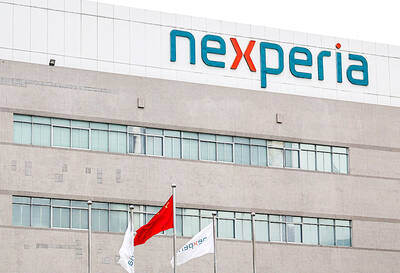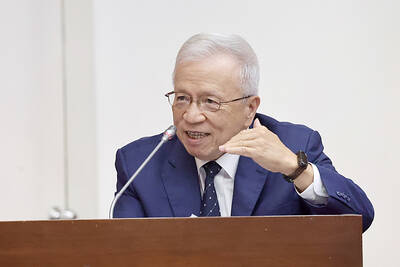Japan yesterday approved as much as ¥590 billion (US$3.9 billion) in subsidies to chip venture Rapidus Corp, committing more money to its ambition to catch up in semiconductor manufacturing.
The additional funding will help Rapidus buy chipmaking equipment and also develop advanced back-end chipmaking processes, Japanese Minister of Economy, Trade and Industry Ken Saito told a news conference in Tokyo.
The amount is on top of ¥330 billion of public money the 19-month-old start-up has already received in its bid to mass produce chips in Japan’s Hokkaido Prefecture and compete with industry leaders Taiwan Semiconductor Manufacturing Co (TSMC, 台積電) and Samsung Electronics Co.

Photo: AFP
“The next-generation semiconductors Rapidus is working on are the most important technology that will dictate the future of Japanese industry and economic growth,” Saito said. “This fiscal year is extremely important for Rapidus.”
The sum is part of about ¥4 trillion Japan has earmarked over the past three years to regain some of its former chipmaking prowess, with Japanese Prime Minister Fumio Kishida targeting ¥10 trillion in financial support to chipmakers, along with the private sector.
Japan has committed billions of dollars into TSMC’s first factory in Kumamoto Prefecture, as well as to Micron Technology Inc’s expansion at its Hiroshima plant to make advanced DRAM.
Geopolitical tensions are spurring governments around the world to broaden domestic capabilities to make semiconductors, which are crucial for running vehicles, power plants and weapons systems, as well as consumer electronics.
The US has also pledged billions of dollars to chipmakers, but delays in licensing and subsidy allocations have held back factory construction plans.
Rapidus is teaming up with the country’s researchers in nanotechnology and materials to close the gap with TSMC in cutting-edge fabrication technology.
TSMC holds the biggest share of the world’s outsourced advanced chip production, with closest rival Samsung struggling for years to catch up.
As much as ¥536.5 billion of the newly approved subsidies will be used to install equipment for the pilot line at Rapidus’ Chitose plant, enlist researchers from IBM Corp, shorten turnaround times and build a production control system, the Japanese Ministry of Economy, Trade and Industry said.
The remaining ¥53.5 billion will be used to develop advanced packaging technologies to help combine multiple chips to generate more capabilities, it said.
Packaging is an area that is grabbing more attention as squeezing more transistors onto a single sliver of silicon gets increasingly costly.
Japan’s three decades of economic stagnation and loss of international competitiveness were caused in part by lack of understanding about the importance of semiconductors for digitalization, decarbonization and economic security, Saito said.
“It’s no exaggeration to say that chips are the foundation for this country’s industries and those of the world,” he said.

JITTERS: Nexperia has a 20 percent market share for chips powering simpler features such as window controls, and changing supply chains could take years European carmakers are looking into ways to scratch components made with parts from China, spooked by deepening geopolitical spats playing out through chipmaker Nexperia BV and Beijing’s export controls on rare earths. To protect operations from trade ructions, several automakers are pushing major suppliers to find permanent alternatives to Chinese semiconductors, people familiar with the matter said. The industry is considering broader changes to its supply chain to adapt to shifting geopolitics, Europe’s main suppliers lobby CLEPA head Matthias Zink said. “We had some indications already — questions like: ‘How can you supply me without this dependency on China?’” Zink, who also

At least US$50 million for the freedom of an Emirati sheikh: That is the king’s ransom paid two weeks ago to militants linked to al-Qaeda who are pushing to topple the Malian government and impose Islamic law. Alongside a crippling fuel blockade, the Group for the Support of Islam and Muslims (JNIM) has made kidnapping wealthy foreigners for a ransom a pillar of its strategy of “economic jihad.” Its goal: Oust the junta, which has struggled to contain Mali’s decade-long insurgency since taking power following back-to-back coups in 2020 and 2021, by scaring away investors and paralyzing the west African country’s economy.

BUST FEARS: While a KMT legislator asked if an AI bubble could affect Taiwan, the DGBAS minister said the sector appears on track to continue growing The local property market has cooled down moderately following a series of credit control measures designed to contain speculation, the central bank said yesterday, while remaining tight-lipped about potential rule relaxations. Lawmakers in a meeting of the legislature’s Finance Committee voiced concerns to central bank officials that the credit control measures have adversely affected the government’s tax income and small and medium-sized property developers, with limited positive effects. Housing prices have been climbing since 2016, even when the central bank imposed its first set of control measures in 2020, Chinese Nationalist Party (KMT) Legislator Lo Ting-wei (羅廷瑋) said. “Since the second half of

AI BOOST: Next year, the cloud and networking product business is expected to remain a key revenue pillar for the company, Hon Hai chairman Young Liu said Manufacturing giant Hon Hai Precision Industry Co (鴻海精密) yesterday posted its best third-quarter profit in the company’s history, backed by strong demand for artificial intelligence (AI) servers. Net profit expanded 17 percent annually to NT$57.67 billion (US$1.86 billion) from NT$44.36 billion, the company said. On a quarterly basis, net profit soared 30 percent from NT$44.36 billion, it said. Hon Hai, which is Apple Inc’s primary iPhone assembler and makes servers powered by Nvidia Corp’s AI accelerators, said earnings per share expanded to NT$4.15 from NT$3.55 a year earlier and NT$3.19 in the second quarter. Gross margin improved to 6.35 percent,